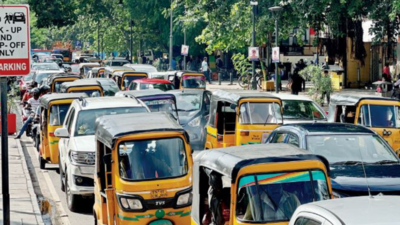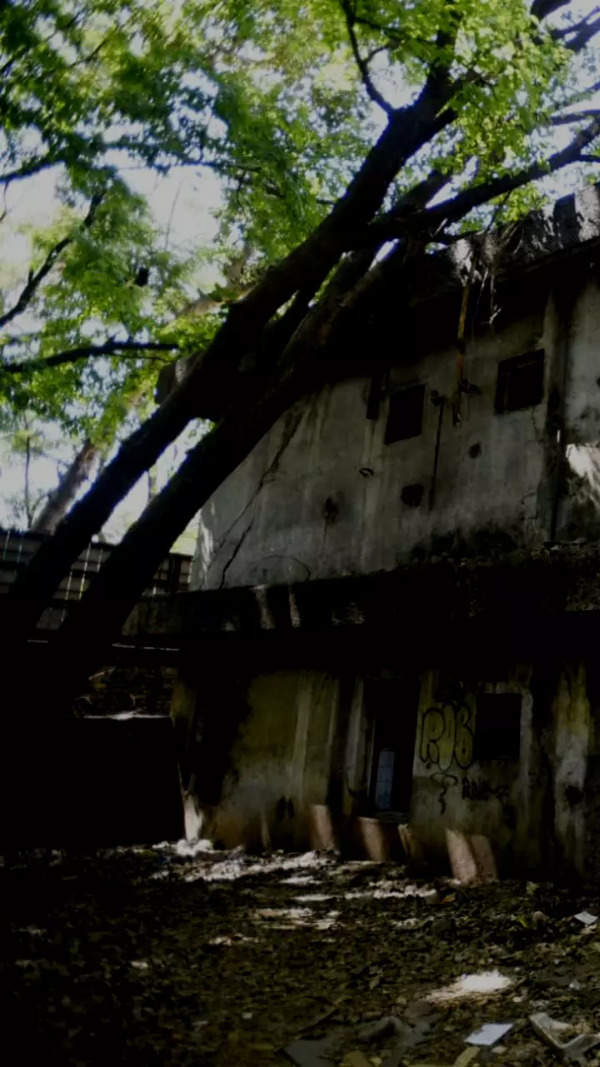- News
- City News
- chennai News
- Chennai Metro diversions send traffic down roads too small
Trending Topics
Chennai Metro diversions send traffic down roads too small

A jampacked stretch in Pondy Bazar. Many interior roads in T Nagar are not capable of withstanding traffic congestion found on main roads.
CHENNAI: I t’s 6pm. It takes Suresh Subramanian between 45 minutes and one hour to drive from Ambattur to Koyambedu as the traffic is diverted via Anna Nagar Second Avenue due to metro rail work. He used to cover the stretch in 25 minutes. The reason: There are no traffic signals or personnel to guide vehicles and minimise congestion at the junction.

Several residents said they find many arterial stretches of the city tough to navigate as nearly traffic on 30 major roads has been diverted for metro work. Dense traffic has been diverted to interior roads that are narrow due to parking and encroachments.

The congestion is severe in three locations – Anna Nagar, T Nagar and Mylapore. With more diversions around the corner, experts say that traffic should be diverted only after carrying out a study. The diversion should not begin unless the narrow roads are re-laid and are cleared of encroachments.
In T Nagar, vehicles from Pondy Bazaar to Nandanam are diverted through Sivagnanam Salai, which is encroached by cars and street-side stalls. The traffic was diverted without repairing the road.
V S Jayaraman, a T Nagar resident, said, “They did not consult residents. The small streets are encroached. There’s no traffic police on Venkatnarayana road resulting in vehicles taking the wrong route, “he said.
According to traffic police data, 1,969 vehicles use Luz during peak time and 1,892 vehicles pass through Tirumangalam. The same number of vehicles cannot be accommodated on the narrow stretches through which the traffic has been diverted. The Indian Road Congress norms says that the carriageways in multiple-lane arterial roads should be 3.5 metres wide. So, if the road has four lanes, the road’s width will be 14 meters. But, an interior street will be only six to seven metres wide leading to congestion like it is in roads around Luz Church.
“Interior roads are not designed for heavy traffic. What if a heavy vehicle breaks down? Do they have a space to pull over? Interior roads may have schools, hospitals and places with high people movement. Are these studied before implementation? Diversions cannot happen overnight without planning,” said Sivasubramaniam Jayaraman, urban transportation engineer, ITDP.
He said “we need to provide a mobility solution to commuters rather than mere traffic diversions.” M S Kumar, a transport export, with Land Transport Authority in Singapore, said “if they are diverting vehicles from arterial roads, the same width has to be given for the vehicles in the diverted route. “Only then can we ensure a lack o f c o m p ro m i s e i n s p e e d . Further, residents need to be consulted before implementing diversions,” he said.
A traffic police official said they prepared a detailed map with alternative routes. “We visit the area and study before finalising the detour. A trial is done before it is implemented,” said the official.

Several residents said they find many arterial stretches of the city tough to navigate as nearly traffic on 30 major roads has been diverted for metro work. Dense traffic has been diverted to interior roads that are narrow due to parking and encroachments.

The congestion is severe in three locations – Anna Nagar, T Nagar and Mylapore. With more diversions around the corner, experts say that traffic should be diverted only after carrying out a study. The diversion should not begin unless the narrow roads are re-laid and are cleared of encroachments.
In T Nagar, vehicles from Pondy Bazaar to Nandanam are diverted through Sivagnanam Salai, which is encroached by cars and street-side stalls. The traffic was diverted without repairing the road.
V S Jayaraman, a T Nagar resident, said, “They did not consult residents. The small streets are encroached. There’s no traffic police on Venkatnarayana road resulting in vehicles taking the wrong route, “he said.
According to traffic police data, 1,969 vehicles use Luz during peak time and 1,892 vehicles pass through Tirumangalam. The same number of vehicles cannot be accommodated on the narrow stretches through which the traffic has been diverted. The Indian Road Congress norms says that the carriageways in multiple-lane arterial roads should be 3.5 metres wide. So, if the road has four lanes, the road’s width will be 14 meters. But, an interior street will be only six to seven metres wide leading to congestion like it is in roads around Luz Church.
“Interior roads are not designed for heavy traffic. What if a heavy vehicle breaks down? Do they have a space to pull over? Interior roads may have schools, hospitals and places with high people movement. Are these studied before implementation? Diversions cannot happen overnight without planning,” said Sivasubramaniam Jayaraman, urban transportation engineer, ITDP.
He said “we need to provide a mobility solution to commuters rather than mere traffic diversions.” M S Kumar, a transport export, with Land Transport Authority in Singapore, said “if they are diverting vehicles from arterial roads, the same width has to be given for the vehicles in the diverted route. “Only then can we ensure a lack o f c o m p ro m i s e i n s p e e d . Further, residents need to be consulted before implementing diversions,” he said.
A traffic police official said they prepared a detailed map with alternative routes. “We visit the area and study before finalising the detour. A trial is done before it is implemented,” said the official.
Start a Conversation
FOLLOW US ON SOCIAL MEDIA
FacebookTwitterInstagramKOO APPYOUTUBE










